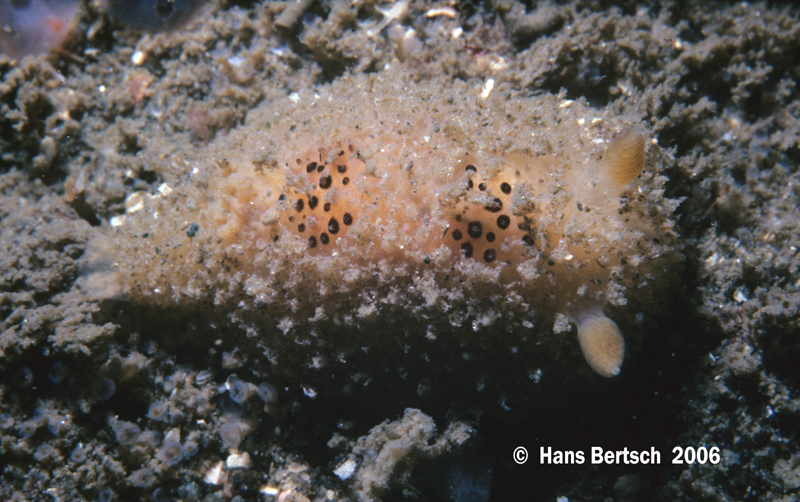 |
Thordisa bimaculata
Photo courtesy of Hans Bertsch
Thordisa bimaculata Lance, 1966
Two months before the first episode of Star Trek aired on television, Jim named this new species, not from Mr. Spock’s planet Vulcan, but from Windnsea Reef, La Jolla, on Capt. Kirk’s fabled water-planet Earth!
“This species is locally common intertidally along rocky shores of La Jolla and San Diego during the summer” (Lance, 1966, p. 72). Additional specimens reported in the original description were collected at 33 m in the Carmel submarine canyon by J. McLean, and at Isla Natividad, Baja California (west of Punta Eugenia and south of Isla Cedros), by Farmer & Collier. Its current known distributional range (Behrens & Hermosillo, 2005) is still the same. (See Jim’s original paper, p. 70, for the latitude and longitude coordinates of these sites.)
The living animals are about 30 mm long and 12 mm wide. The body is rounded in front, and has near parallel sides with a bluntly pointed tail that protrudes past the notum.
Overall body color varies from bright orange to dull yellowish. Two contrasting brown to blackish splashes of spots and circles are on the midline between the rhinophores and gills.
“The entire dorsal surface of the notum is thickly set with inflated villous papillae longest medianly and gradually decreasing in size outward. In life the larger papillae are constricted near the base, become inflated about halfway up, and terminate in a gradually tapering point. Protruding spicules occur in the constricted areas” (p. 73).
“The anterior margin of the foot is rounded and bilabiate with both lips entire, not cleft in life....Two slender digitform tentacles arise on either side of the mouth somewhat posterior to the lateral lobes. Unlike the ventral cephalic topography of many cryptobranch dorids, the tentacles of Thordisa bimaculata are not prolongations of the lateral margins of the oral lobes, but arise independently” (pp. 73–74).
The labial cuticle is strong, nearly transparent, and without any trace of armature. Its surface is tessellated. A typical individual 28 mm in length had a radula formula, 32 x 8.34.0.34.8 at the level of the 17th row. Another specimen of the same length had the formula 31 x 6.29.0.29.6 at the same level....The innermost laterals are small hamate hooks and increase in size outwards. The outermost 6–10 laterals (marginals) abruptly become bristled, bear a prominent cusp,...and decrease in size outwards” (pp. 74–75).
“Specimens with varying amounts of sand grains attached between the notal papillae are often observed in the field. In some cases the animals are heavily encrusted and barely discernible against the substrate” (p. 75).
The line drawings linked to this BOW are Jim’s well-executed figures accompanying the original description.
This pretty spongivore (a typical dorid gustatory preference) was one of 6 species named by Jim Lance (1928-2006) that are currently recognized as valid. Four other species are synonyms of prior-named species. His species descriptions were published in 5 papers between 1962 and 1968.
Let Thordisa bimaculata “Live Long and Prosper” in its Maritime Trek!
Reference
Lance, James R. 1966. New distributional records of some northeastern Pacific Opisthobranchiata (Mollusca: Gastropoda) with descriptions of two new species. The Veliger 9 (1): 69–81.
Imperial Beach, California
August 2006
on 12 September 2006. And she will vote! Congratulations Rosa!

